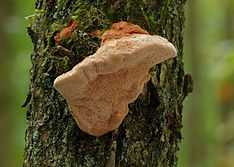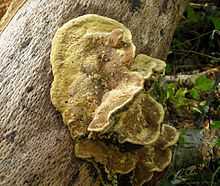Hapalopilus nidulans
| Hapalopilus nidulans | |
|---|---|
 | |
| Scientific classification | |
| Kingdom: | Fungi |
| Division: | Basidiomycota |
| Class: | Agaricomycetes |
| Order: | Polyporales |
| Family: | Polyporaceae |
| Genus: | Hapalopilus |
| Species: | H. nidulans |
| Binomial name | |
| Hapalopilus nidulans (Fr.) P.Karst. (1881) | |
| Synonyms[1] | |
| |
Hapalopilus nidulans, commonly known as the tender nesting polypore or the cinnamon bracket, is a species of polypore fungus in the family Polyporaceae. First described in 1821, this widely distributed species grows on the fallen or standing decaying wood of deciduous trees. Fruit bodies are in the form of kidney-shaped to semicircular, cinnamon-orange-brown brackets. The poisonous fruit bodies cause neurotoxic symptoms if ingested.
Taxonomy
The species was first described by Elias Magnus Fries in 1821, as Polyporus nidulans.[2] Petter Karsten transferred it to its current genus, Hapalopilus, in 1881.[3] It has been shuffled to several genera throughout its taxonomic history. Hapalopilus rutilans is a synonym.[1] The polypore is commonly known as the "cinnamon bracket"[4] or the "tender nesting polypore".[5]
Description

The cap is fan-shaped to semicircular and convex, reaching a diameter of 2.5–12 cm (1.0–4.7 in). It lacks a stalk, and is instead attached broadly to the substrate. The fruit bodies are initially soft and spongy, but become hard and brittle once they have lost their moisture. The cap surface is covered with matted hairs, has shallow concentric furrows, and a dull brownish-orange color. The flesh is up to 3 cm (1.2 in) thick at the thickest part, and is a pale cinnamon color. The pore surface is yellowish to brownish, and the pores are angular, numbering about 2–4 per millimeter.[5] In young fruit bodies, the pore surface bruises reddish brown. The mushroom's odor and taste ranges from sweetish to indistinct.[6]
Fruit bodies produce a white spore print. Spores are elliptical to cylindrical, smooth, hyaline (translucent), and measure 3.5–5 by 2–3 μm. A chemical test can be used to help with identification: all parts of the fruit body will instantly stain bright violet if a drop of dilute (3–10%) potassium hydroxide (KOH) is applied.[5]
The fruit bodies are inedible,[5] and have been reported to have neurotoxic effects attributable to the compound polyporic acid. One German family (who later recovered fully) experienced nausea, impaired movement, visual impairment, liver and kidney failure; symptoms began about 12 hours after consuming the mushroom. Additionally, the urine of all three poisoning victims temporarily turned violet.[4] Used in combination with alkaline mordants, the fruit bodies can be used in mushroom dyeing to produce violet colors.[4]
Similar species

Some other polypores are roughly similar in appearance to H. nidulans and might be confused with it. Phellinus gilvus, has a yellowish to rusty-yellow fibrous cap, yellowish-brown flesh that stains black in KOH, and a grayish-brown to dark brown pore surface. Hapalopilus croceus produces large fruit bodies with caps up to 20.5 cm (8.1 in) in diameter. Its pore surface is bright reddish orange when fresh, and its flesh stains red with KOH.[5] The "beefsteak fungus" Fistulina hepatica has soft, blood-red fruit bodies that ooze red juice.[4]
Habitat and distribution
Fruit bodies of Hapalopilus nidulans grow singly, in groups, or in fused and overlapping clusters on decaying deciduous trees.[5] Preferred hosts include oak, beech, and birch, although it has been recorded rarely on conifer wood as well. Fruiting typically occurs from early summer to autumn, but the tough fruit bodies are persistent and may be encountered out of the usual growing season.[6] The fungus is widely distributed, and has been found in Australia,[7] Africa, Asia, Europe, North America, and Oceania.[8] In North America, it is more common in the eastern and southwestern part of the continent.[9]
References
- ↑ 1.0 1.1 "Species synonymy: Hapalopilus nidulans (Fr.) P. Karst.". Index Fungorum. CAB International. Retrieved 2012-10-18.
- ↑ Fries EM. (1821). Systema Mycologicum (in Latin) 1. Lund, Sweden: Ex Officina Berlingiana. p. 362.
- ↑ Karsten PA. (1881). "Enumeratio Boletinearum et Polyporearum Fennicarum, systemate novo dispositarum". Revue mycologique Toulouse (in Latin) 3 (9): 16–19.
- ↑ 4.0 4.1 4.2 4.3 Roberts P, Evans S. (2011). The Book of Fungi. Chicago, Illinois: University of Chicago Press. p. 390. ISBN 978-0226721170.
- ↑ 5.0 5.1 5.2 5.3 5.4 5.5 Bessette A, Bessette AR, Fischer DW. (1997). Mushrooms of Northeastern North America. Syracuse, New York: Syracuse University Press. p. 390. ISBN 978-0815603887.
- ↑ 6.0 6.1 Roody WC. (2003). Mushrooms of West Virginia and the Central Appalachians. Lexington, Kentucky: University Press of Kentucky. p. 375. ISBN 0-8131-9039-8.
- ↑ May TW, Milne J, Shingles S. (2003). Fungi of Australia: Catalogue and Bibliography of Australian Fungi. Basidiomycota p.p. & Myxomycota p.p. Csiro Publishing. p. 173. ISBN 978-0-643-06907-7.
- ↑ Zhishu B, Zheng G, Taihui L. (1993). The Macrofungus Flora of China's Guangdong Province (Chinese University Press). New York, New York: Columbia University Press. p. 199. ISBN 962-201-556-5.
- ↑ Phillips R. (2005). Mushrooms and Other Fungi of North America. Buffalo, New York: Firefly Books. pp. 302–3. ISBN 1-55407-115-1.